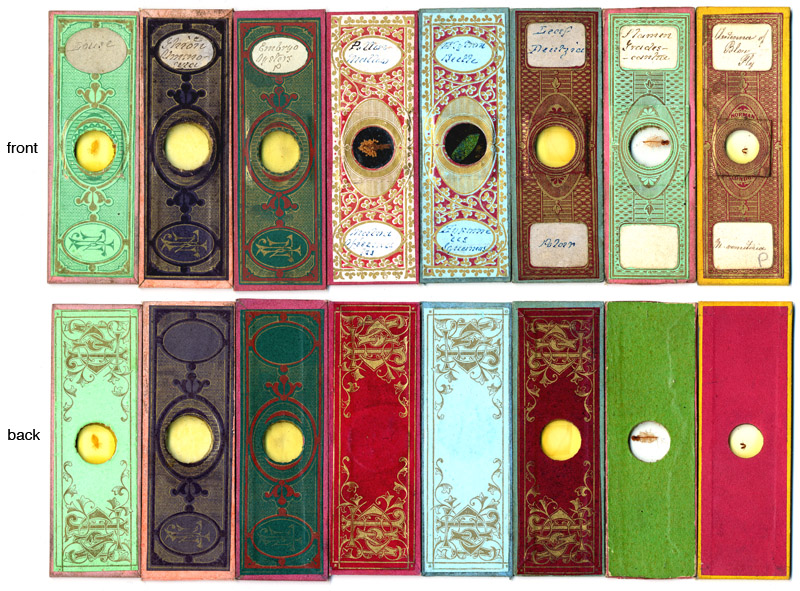
John Thomas Norman (1807-1893), and his Microscopist Family
by Brian Stevenson, Kentucky, USA
The John T. Norman microscopy business operated for 90 years, first by John, then by his sons Alfred and Edwin. John Norman stated that his business was established in 1846. Alfred Norman continued production of microscope slides until his own death, in 1936. It is no wonder that so many slide collections contain numerous slides bearing the J.T. Norman name. Brian Bracegirdle wrote an admirable paper on John and Alfred Norman for the Quekett Journal of Microcopy in 1996. Additional articles in the QJM by Stanley Warren and Brian Darnton added further information to our knowledge of John Norman and company. With that in mind, this article focuses on aspects of John Norman’s life and business that have not previously been widely publicized. One point that this research brought out is that, contrary to Brian Bracegirdle’s statement in Microscopical Mounts and Mounters, the output of the J.T. Norman slide-making enterprise was not largely made by only two men. This was truly a cottage industry, in that the slide-making and selling business was operated in the family home. Five of John Norman’s sons are known to have worked in the J.T. Norman business, most of them for several decades. The Normans were not wealthy, so everyone in the household probably helped with the business in some manner. The known contributions of the Norman children are described at the end of this essay.

Figure 1. Examples of early, papered microscope slides from J.T. Norman. The very ornate patterns on the left are probably his earliest works. Later slides used either an off-the-shelf, generic paper (second and third from the right), or a customized version of that pattern, in which “Norman” and “London” were embedded in the pattern surrounding the specimen. Later papered slides tend to have dark green, plain paper on the reverse (e.g. second from the right) The handwriting on all these slides is presumably that of John Norman, Senior.
John Thomas Norman was probably born during January, 1807. He was christened February 8, 1807 at St. Mary Whitechapel, Tower Hamlets, Middlesex (now within London city). His parents, Thomas and Sarah Cook Norman, had married the previous spring, on April 6, 1806. According to John’s 1838 marriage record, his father was a bookbinder. At the time of John’s christening, the family lived in Queen Ann Street.
John T. Norman married Ann Bowell on February 13, 1838, at the Parish Church of St. Mary Aldermary. The couple lived at 8 Addle Hill, Whitechapel. On the parish marriage record, John described his occupation as “brush maker”. The types of brushes he made are unknown, but he continued with that line of work until at least 1850. Norman’s brush- and slide-making businesses evidently overlapped for several years.
The Normans’ first son, also name John Thomas, was born August 20, 1838. The short time between John and Ann’s marriage and their son’s birth was not unusual for those times. Contrary to modern perceptions, cohabitation before marriage was quite common. Also, during the 1800s, marriage in Britain was frequently conducted by “banns”, in which the plans of a couple to marry were announced from the parish church pulpit on three consecutive Sundays. If no-one presented a reason why the couple should not be united, they were then considered married without any further ado. A relic of this tradition is found in many modern western marriage ceremonies, in which spectators are asked if anyone has any objections - “speak now, or forever hold your peace.” The City of London birth record for John Jr. described John Sr. as being a “brush maker”.
A second son, William Joseph, was born January 14, 1840. Both John Jr. and William were christened on July 28, 1847, at St. John the Baptist, Shoreditch. John Sr. described his occupation as “microscope maker” on their christening records. Although John Norman is known to have sold microscopes (see Fig. 3, and Bracegirdle, Quekett Journal of Microscopy, 1996), there is no clear evidence that he actually made them. His sons’ christening records may refer to John’s slide-making business.
The 1841 census found John Sr., Ann and William living on Pearson St., Shoreditch, along with Ann’s unmarried sister Eliza. John’s occupation was again described as “brush maker”.
Ann Norman died later that year, and was buried September 1, 1841 at St. John the Baptist, Hoxton, Hackney.
John Sr. remarried on January 14, 1850, to Mary Ann Boroff. Both John and Mary Ann lived at 3 Walbrooke Place, Shoreditch at the time of their marriage. John once again described his occupation as “brush maker”. A daughter, named Harriet, was born approximately 1848. I have not found her birth record, but presumably John and Mary Ann were the parents. She may, however, have been adopted, as she does not appear with the family until the 1861 census. A second daughter, Mary Ann, was born May 31, 1850. John announced himself to be a “brush maker” on her parish christening record.

Figure 2. An example of an early advertisement from 10 Fountain Place. From the Lancet, 1854.
By the following March, the Norman family had moved to 10 Fountain Place. It was from this location that J.T. Norman issued his earliest known advertisements (e.g. Figure 2).
The first records of J.T. Norman as a scientist also come from Fountain Place. The Zoologist reported that The British Entomological Society met “at the Society's rooms, 10, Fountain place, City-road” on May 5, 1851. At that meeting, “Mr. Norman read the following account of the habits of a species of spider, from Dickens's 'Household Words' of April 5”. The report was signed by the Society’s secretary, J. Norman. The next month, “Mr. Norman presented to the Society a specimen of Vanessa Antiopa, taken in Lordship Lane, Stoke Newington, in 1847”. On May 4, 1852, “The President announced a donation of 276 Lepidopterous insects to the Society's Cabinet, from Mr. J. T. Norman”. It is not clear whether these were microscope slides or whole, dried insects. Norman continued to be involved with the Society of British Entomologists for several more years. The 1859 edition of The Entomologist’s Annual noted among its “List of British Entomologists”, “Norman, J.T., 10, Fountain Place, City Road, EC”.
John Quekett’s second edition (1852) of A Practical Treatise on the Use of the Microscope included Norman in his list of esteemed slide makers: “For the advantage of those who are resident in the country, as well as for those who may be desirous of investigating any of the various branches of natural history, whether for amusement or otherwise, it has been deemed advisable to divide vegetable and animal structures into different classes. Mr. Topping, of No. 4, New Winchester Street, Pentonville Hill, one of our most ingenious preparers of microscopic objects – Mr. Darker, of No. 9, Paradise Street, Lambeth – Mr. J.T. Norman, of No. 10, Fountain Place, City Road – Mr. J. W. Bond, of No. 1. Emma Street, Ann’s Place, Hackney Road – and Mr. C.H. Poulton, of Southern Hill, Reading – have obligingly furnished the author with lists of the most important specimens of the various classes which they are in the habit of supplying to their customers; from these as well as from one which has been derived from a variety of other sources, including the author’s own experience, the following collection of the most interesting subjects for examination has been drawn up”. The third, 1855 edition again mentioned J.T. Norman.
Other sources recommended John Norman as a preparer of assorted specimens. Dr. Boon Hayes, writing in the 1853 Medical Times & Gazette wrote “The following list of … specimen preparers may be useful to gentlemen interested in the study of histological anatomy: … Norman, 10, Fountain-place, City-road”. Jabez Hogg’s 1856, second edition of The Microscope: Its History, Construction, and Applications wrote “Mr. J.T. Norman, preparer of specimens for the microscope, 10 Fountain Place, City Road, furnished the author with a … list for publication”. Instructions to Young Sportsmen in All that Relates to Guns and Shooting, 11th ed., (1859) gave a “List of the London Preservers of Birds” that included Charles M. Topping and “Norman, John Thomas (microscopic), 14 [sic] Fountain Place, City Road, EC”.
By the time of the 1861 census of England, the Norman family had moved to 178 City Road, St. Luke. John apparently remained at that home until just before his death, in 1893. This location served as the family home, workshop and retail store for most of that time. Numerous advertisements of microscope slides and apparatus were issued from this address in the intervening years (Figure 3A and D).
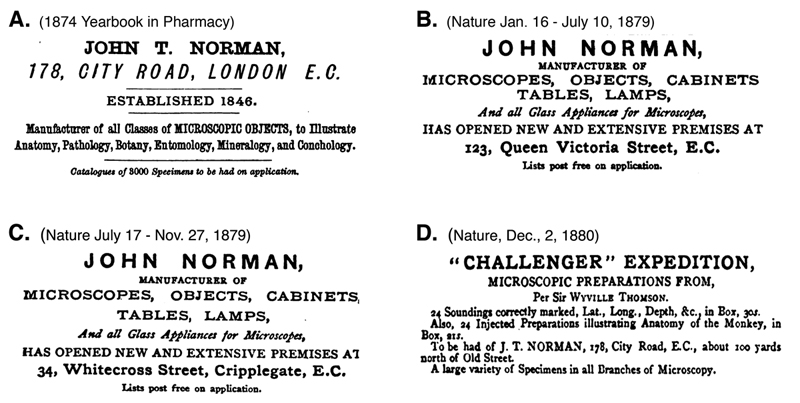
Figure 3. Examples of John Norman’s advertisements from 178 City Road (A and D), flanking advertisements for the failed ventures on Queen Victoria and Whitecross Streets. (B and C).
John Norman entered a “good general collection” of microscope slides to the 1862 London International Exhibition. He was awarded a prize medal for that contribution (Figure 4). Norman also exhibited his work at the 1867 Paris International Exhibition.
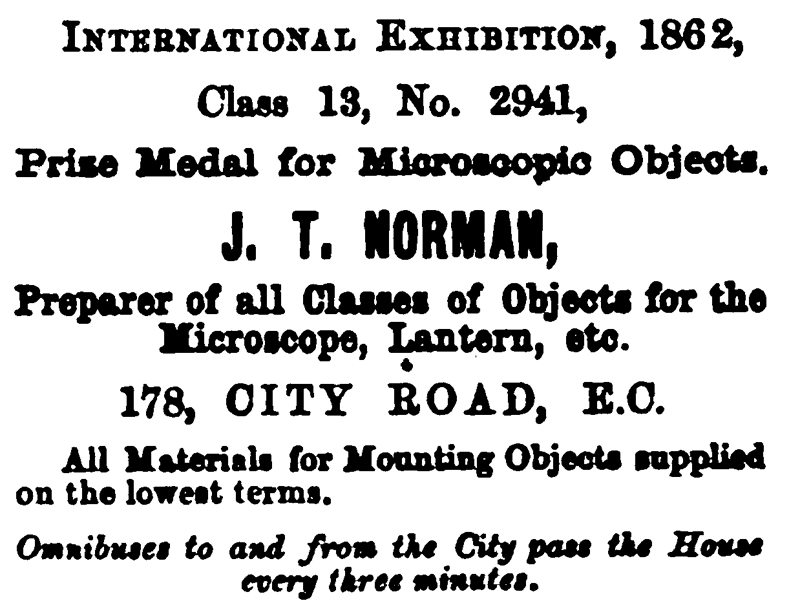
Figure 4. An 1863 advertisement for J.T. Norman, announcing his prize medal from the 1862 London International Exhibition. From The Intellectual Observer.
During 1879, Norman made two attempts to expand his business, both of which failed. In late 1878 or early 1879, he opened a retail shop at 123 Queen Victoria St (Figure 5). He advertised heavily in Nature, with ads appearing in every issue between January 16 and July 10, 1879 (Figure 3B). The following week, in the July 17 issue of Nature, Norman was advertising from a different address, 34 Whitecross St. (Figure 3C). In what looks like a surprisingly bad business decision, Norman moved his shop without making an announcement. Presumably, the Queen Victoria St. shop did not live up to expectations, and Norman decided to try his luck at another location. Advertisement for the Whitecross St. shop ended abruptly in November, 1879. Both the Queen Victoria St. and Whitecross St. shops appear to have been dedicated emporia, with the Norman family continuing to live in the home at 178 City Rd. Advertisements began again for the City Road shop in late 1880 (Figure 3D).

Figure 5. Microscope slides from J.T. Norman labeled with his addresses at 123 Queen Victoria Street (A) and 178 City Road (B). The uncommon “NORMAN” monogram trademark on slide A was also found on a box of slide preparing supplies described by Brian Darnton in the Quekett Journal of Microscopy, 1999.
In addition to operating his own retail shop, J.T. Norman sold slides through other microscopy suppliers. The 1870 catalogue from James W. Queen & Co. (Philadelphia, USA) included a “classified list of first-class microscopic objects, with many new, rare, and interesting specimens, affording instructive illustrations in anatomy, physiology, botany, entomology, geology, and mineralogy, including the finest preparations of Wheeler, Norman, Topping, Moller, Bourgogne, Verick, Walmsley, and other foreign and American artists”. Examples of slides made by the J.T. Norman company that have other retailers’ labels attached are shown in Figure 6. Some of these were probably sold directly from Norman to the retailer, while others were likely sold second hand.
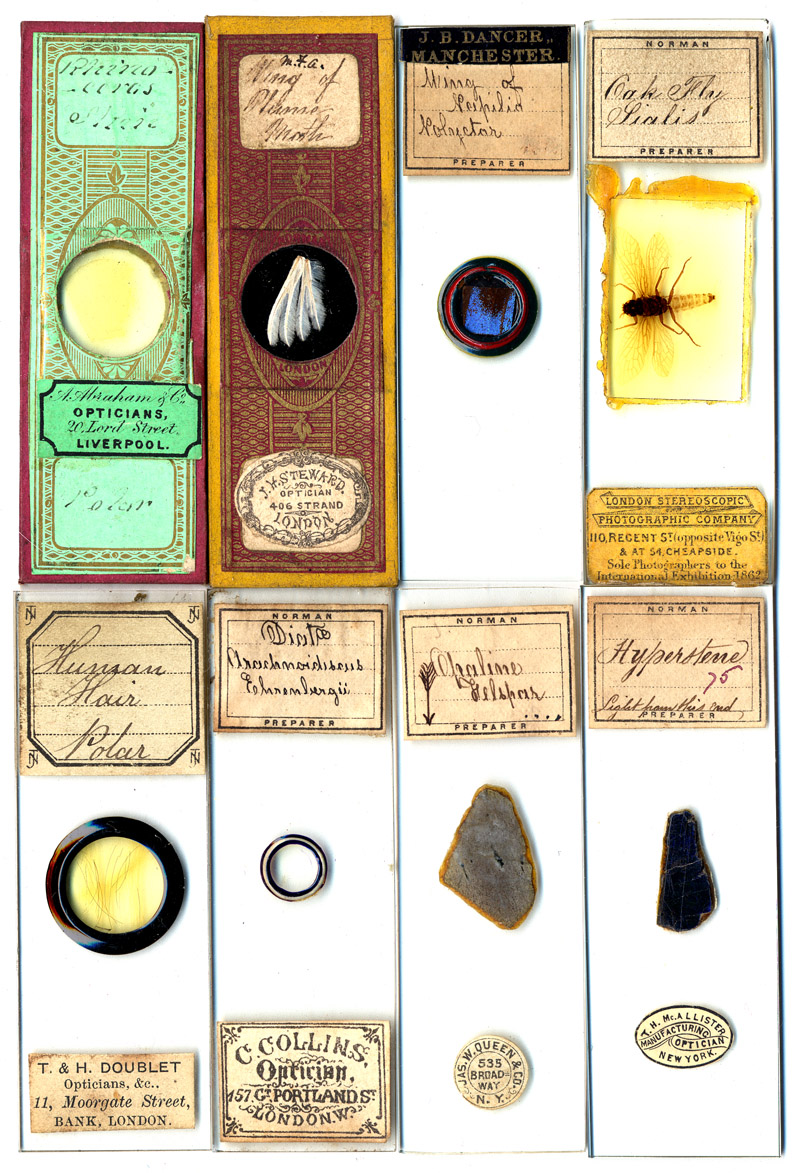
Figure 6. Examples of microscope slides made by the Norman business, with labels from other retailers. A list of Normans’ customers, described by Brian Bracegirdle in the Quekett Journal of Microscopy, 1996, included C. Collins, T. & H. Doublet and J.W. Queen. Note how J.B. Dancer placed his name directly over Norman’s, thereby taking credit for the preparation.
Norman was not above re-selling slides he obtained from other makers, which makes good business sense (e.g. Figure 7). Figure 7B shows a slide with a convoluted history. The front bears paper with Edmund Wheeler’s monogram and characteristic oval label. Norman placed his name plate on top of the Wheeler paper. Turning the slide over reveals that the coverslip was attached with red wax and black gummed paper, a method that is not generally associated with either Wheeler or Norman. As an aside, although the red wax and black paper method of mounting is often attributed to Andrew Pritchard, that microscopist is not known to have actually made or described slides produced in such a manner.
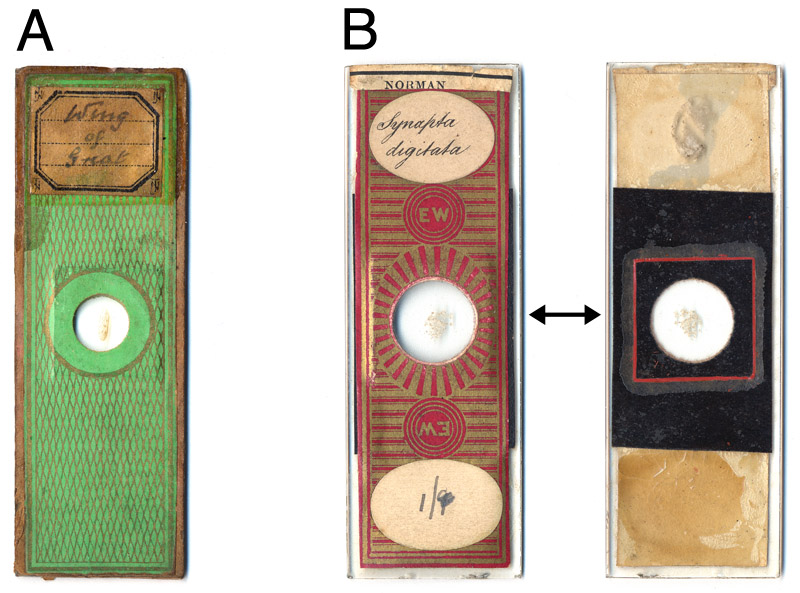
Figure 7. Two slides made by other mounters, to which Norman labels were subsequently attached. (A) “Wing of Gnat”, by Cornelius Poulton (died 1854). (B) Front and rear views of a microscope slide labeled by both J.T. Norman and Edmund Wheeler, but evidently of much older vintage.
John Norman wrote an interesting account of the origins of one of his specimens, in 1863. This was a rabbit infected with trichina worms and cysts (Figure 8).
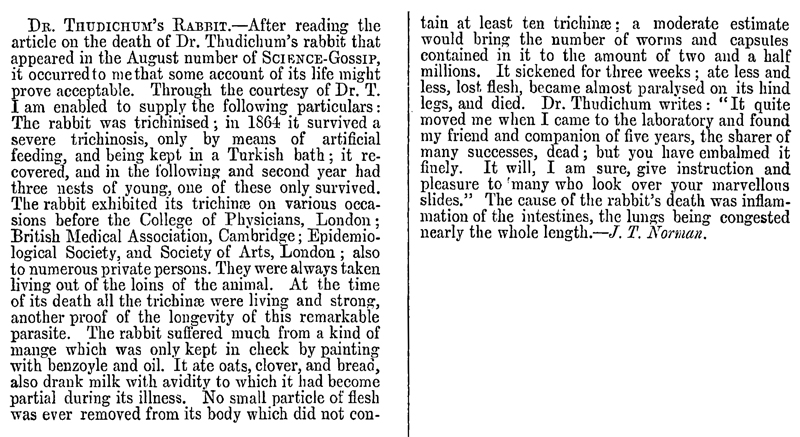
Figure 8. A report from J.T. Norman on the source of one of his specimens. From Hardwicke’s Science-Gossip, 1863.
Shortly before his death, John Norman Sr. signed over his business to two of his sons, Alfred and Edwin. At about the same time, Alfred and Edwin signed a contract with their brother Charles, in which Charles pledged not to “trade or carry on any business in the name of John Thomas Norman”. That contract has been taken as an implication that Charles had been selling independently using the J.T. Norman name, and that his brothers Alfred and Edwin wanted him to stop (Bracegirdle, Quekett Journal of Microscopy, 1996). However, census records indicate that Charles lived with his parents and worked for his father for nearly his whole life. The 1891 census, taken only 1 1/2 years before Charles promised not to use the John T. Norman name in business, indicates that Charles and his wife Susan lived with father John at 178 City Road. Brothers Alfred and Edwin lived elsewhere. This information suggests that the contract Charles signed in Oct., 1892 actually dealt with future possibilities. Apparently, Edwin and Alfred wanted to run their business under their father’s name, and Charles was willing to let them. Why Charles stepped aside will probably never be known. Charles set up an independent optician business nearby, where he likely continued to make and sell slides (see below).
John Thomas Norman died February 13, 1893, at his daughter Sarah’s home in Penge, a suburb south of London. This was slightly more than 2 months after he signed over his business to Alfred and Edwin. The recorded cause of death was “decay of nature”.
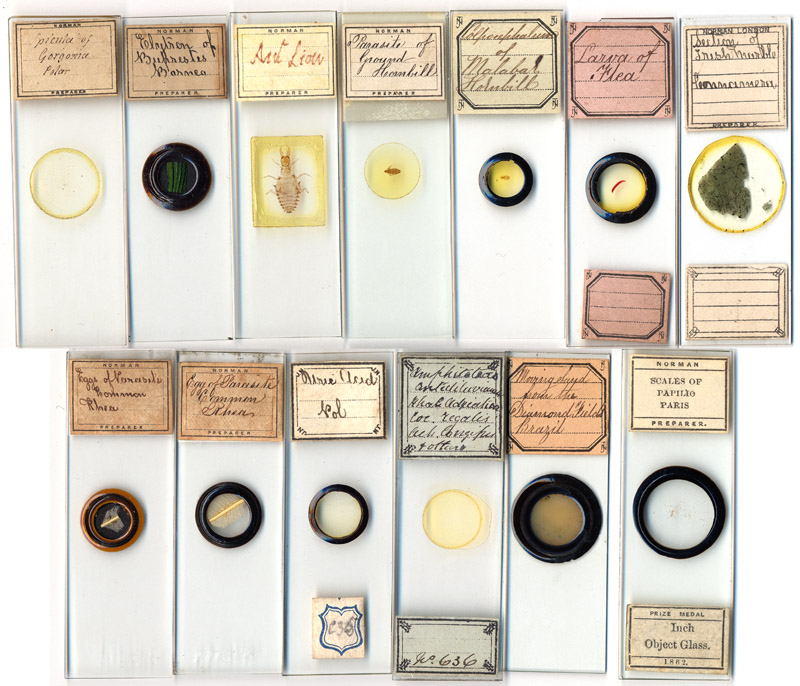
Figure 9. Examples of slides from J.T. Norman, bearing a variety of label styles. Several distinct handwriting styles are evident. The two slides on the left side of the lower row are of the same specimen. The block printing on the upper left slide is the same as found on early Norman slides (e.g. Figure 1), and is presumably that of J.T. Norman, Sr.
John T. Norman is known to have had 9 children, two with his first wife Ann, and 7 (possibly only 6) with second wife Mary Ann. Five of the sons are known to have worked for the J.T. Norman slide making business. Since the family home was also the slide-making workshop, it would be surprising of the women of the family did not also pitch in to some extent, even if only cutting and pasting labels. Following are brief biographies of John Norman’s children. Signatures of John Sr., John Jr. Charles, Harriet, Sarah and Mary Ann follow as Figure 10.
John Thomas Norman. The eldest son was born August 20, 1838, and christened July 28, 1847. He was not at home on census night, 1841. He shows up on the 1851 census as a 13 year old scholar. The 1861 and 1871 censuses recorded him living with his father and family at 178 City Road, and working as a “microscopic object maker” and an “optician”, respectively. During that era, any worker dealing with lenses (including a microscope slide maker) was considered to be an optician. John Sr. was also recorded as being an optician on the 1871 census. John Jr. joined the Quekett Microscopical Club in 1867, and remained a member until the end of 1869. He married Sarah Noakes at the Trinity Church, St. Marylebone in 1878. John’s home parish was then the same as 178 City Road, so presumably he still lived with his father, step mother and siblings. He described himself on his marriage record as being an “optician”. During March, 1884, “J. Norman, jun.” donated “2 slides of sticklebacks” to the Royal Microscopical Society. I have not found any further records of him. He may have taken another occupation and thereby become indistinguishable on census records, died, emigrated, or records with his information may have been lost. Thus, John T. Norman, Jr. worked for the Norman microscopy business from childhood until at least 1878, and possibly longer.
William Joseph Norman. Several census records give William’s middle initial as “H”, but his parish christening record names him William Joseph. He was born January 14, 1840, and christened July 28, 1847. He appears on the 1841 census as a 1 year old, and on the 1851 census as an 11 year old scholar. In 1861, he was listed as a “microscopic object maker”, and in 1871, as an “optician”. During the summer of 1872, William married Mary Ekins. William and Mary appear on the 1881 census living at 4 Laburnum Cottages, Walthamstow, Essex. His occupation was listed as “histologist”. I have not located his 1891 address, but in 1901 he and Mary were still at the Walthamstow address, and he was reported to be an “entomologist”. A Norman record book from the 1880s lists William as making microscope slides of arranged butterfly scales for the firm. William died in 1917. William apparently worked as a slide maker for the Norman business from childhood until his death at the age of 77.
Harriett Norman. Shows up with the family as a 13 year old scholar on the 1861 census, but absent from the 1851 census. I have not located her birth record. She lived at home at the time of the 1871 census, and worked as a “milliner”. She married Johann Ludwig Kalb, a German bootmaker, in 1881. She died in 1928.
Mary Ann Norman. Born May 31, 1850, and christened July 3, 1850. The 1871 census listed her at home, and working as a “milliner”, like Harriet. She married a printer named George Brookes in 1877.
Thomas Norman. Born in 1853, he appears on the 1861 census as a 7 year old scholar, then disappears from records. His fate is not known.
Sarah Norman. Born in 1855, she married a printer named Richard Crawford in 1876. Her father died at their house in Penge, and Sarah signed John’s death certificate as witness. Sarah died in 1931.
Edwin Norman. Born in 1857. Lived with his parents through the 1881 census. Edwin joined the Quekett Microscopical Club in March, 1881, but resigned during 1888. He was not at his father’s house at the time of the 1891 census. Edwin and Alfred operated the J.T. Norman slide making business from 1893. Although Edwin is not specifically described as a slide maker on census records, it is highly unlikely that he would have been excused from the family business as a child, at least. Edwin presumably also made slides after he and Alfred took over the business. He died in 1897.
Charles Norman. Born in 1859, he was listed at his parents’ house on all censuses between 1861 and 1891. The 1891 census recorded his as being an “optician”, as was his father. Charles married Susan Fletcher in 1889, and brought her home to his father’s house. In late 1892, Charles signed an agreement with Edwin and Alfred that he would not sell slides under the name of John Thomas Norman. The 1895 and 1899 Post Office Directories of London reported that Charles Norman was operating an optician’s shop at 119 Old Street, EC. This location was less than 5 minutes walk from 178 City Road. Charles died some time before 1900, when his widow Susan married William Briggs. Charles death record has not yet been identified. He was not the man of that name who died in the City Road area in 1897. Thus, Charles worked for the Norman slide-making business from childhood until he was 33, and probably worked as an independent slide-maker for the last few years of his life.
Alfred Norman. Born in 1861. He married in 1882. The christening record of his first child, Jane Lilian, described Alfred’s occupation as “porter”, indicating that he tried a different line of work for a short while. When his second child, Alfred Thomas, was christened in 1885, Alfred was back to work as an “optician”. At the time of the 1891 census, he, his wife Mary Ann and their 5 children lived at 28 Roseberry Place, Hackney. Alfred was recorded on that census as being an employed “microscopical lapidary”. He and Edwin took over the J.T. Norman business in 1892, and ran it after Edwin died in 1897. The 1901 census records Alfred as being a “producer of specimens for microscope”, who worked on his “own account”. Alfred died in 1936.

Figure 10. Signatures of Norman family members, from parish marriage records. These may be helpful in identifying other writings by them. (A) John T. Norman, Sr. and Ann Bowell from their 1838 marriage. John T. Norman, Jr., from his 1878 marriage. (C) Charles Norman, from his 1889 marriage. (D) Sarah, Harriet, Mary Ann and John, from Sarah’s 1876 marriage. Comparisons of the “John” signature with that of the son (panel B) and the father (panel A and Bracegirdle, 1996) suggests that this was John Sr.’s signature. I did not locate parish records for William’s or Alfred’s marriage, or any record with Edwin’s writing. Examples of Alfred’s and William’s handwriting can be seen in B. Bracegirdle, Quekett Journal of Microscopy, 1996.
Comments to the author will be welcomed.
Acknowledgements
My thanks to Howard Lynk for many helpful comments during this research and on the manuscript.
This and other microscopists’ biographies can also be seen on the author’s web site, http://microscopist.net
Resources
Bracegirdle, Brian (1996) J.T. Norman - microscopical mounter, Quekett Journal of Microscopy, Vol 37, pages 514-535
Bracegirdle, Brian (1998) Microscopical Mounts and Mounters, Quekett Microscopical Club, London, pages 71-72
Birth record of John Thomas Norman (1838) City of London, Vol. 2, page 120
Darnton, Brian (1999) The Norman inheritance: renovating, conserving, mounting and evaluating the material, Quekett Journal of Microscopy, Vol. 38, pages 377-383
Death record of John Thomas Norman (1893) Croydon, Vol. 2a, page 180
England vital statistics, including birth, marriage, death and census records, accessed through ancestry.co.uk
The Entomologist’s Annual for MDCCCLIX (1859) Van Voorst, London, page 25
Hayes, Boon (1853) Histological anatomy and microscopical manipulation, Medical Times & Gazette, Feb. 12, pages 155-158
Hogg, Jabez (1856) The Microscope: its History, Construction, and Applications. second edition, page 307
The Intellectual Observer (1863) advertisements, Dec. issue
Journal of the Royal Microscopical Society (1884) List of donations, Vol. 1, page 332
The Lancet (1854) Advertisement for J.T. Norman, Vol. 1, April 22
Nature (1879) advertisements for John Norman, vol. 19, page lxxxv (Jan. 16) and other pages up to Vol. 20, page lxxxvi (July 10).
Nature (1879) advertisements for John Norman, vol. 20, page xciii (July 17) and other pages up to Vol. 21, page xxx (Nov. 27).
Nature (1880) advertisement for J.T. Norman, vol. 23, page xxiv (Dec. 2)
Norman, J.T. (1863) Dr. Thudichum’s rabbit, Hardwicke’s Science-Gossip, Vol. 5, page 238
Paris Universal Exhibition of 1867: Catalogue of the British Section (1867) page 93
Parish christening record of Alfred Thomas Norman (1885) St Philip Dalston
Parish burial record of Ann Norman (1841) St. John the Baptist, Hoxton
Parish christening record of Jane Lilian Norman (1883) St Philip Dalston
Parish christening record of John Thomas Norman (1807) St. Mary Whitechapel
Parish christening record of John Thomas Norman (1847) St. John the Baptist, Hoxton
Parish christening record of Mary Ann Norman (1850) St. John the Baptist, Hoxton
Parish christening record of William Joseph Norman (1847) St. John the Baptist, Hoxton
Parish marriage record of Thomas Norman and Sarah Cook (1806) St. Mary Whitechapel
Parish marriage record of John Thomas Norman and Ann Bowell (1838) St. Mary Aldermary
Parish marriage record of John Thomas Norman and Sarah Noakes (1879) St. Marylebone
Parish marriage record of Harriet Norman and Johann Ludwig Kalb (1881) St. Barnabas, Finsbury
Parish marriage record of Mary Ann Norman and George Brookes (1881) St. Barnabas, Finsbury
Parish marriage record of Sarah Norman and Richard William Crawford (1877) St. Barnabas, Finsbury
Priced and Illustrated Catalogue of Optical Instruments, Made, Imported and Sold, Wholesale and Retail (1870) James W Queen & Co., Philadelphia, page 73
Marriage record of John Thomas Norman and Mary Ann Boroff (1850) Shoreditch, Vol. 2, page 373
Post Office Directory of London (1895) Opticians
Post Office Directory of London (1899) Opticians
Quekett, John Thomas (1852) A Practical Treatise on the Use of the Microscope: Including the Different Methods of Preparing and Examining Animal, Vegetable, and Mineral Structures, 2nd Edition, page 399. H. Bailliere, London
Quekett, John Thomas (1855) A Practical Treatise on the Use of the Microscope: Including the Different Methods of Preparing and Examining Animal, Vegetable, and Mineral Structures, 3rd Edition, page 430. H. Bailliere, London
Journal of the Quekett Microscopical Club (1868-69) Lists of members, Vol. 1, appendix
Stevenson, Brian (2009) JT Norman’s retail shops on Queen Victoria Street and Whitecross Street, Quekett Journal of Microscopy, Vol. 41, 155-159
Warren, Stanley (2001) Comments on a letter from J.T. Norman, Quekett Journal of Microscopy, Vol. 39, pages 189-191
Yearbookof Pharmacy (1874) advertisement for John T. Norman, page 676.
Zoologist (1851) Proceedings of the British Entomological Society/Society of British Entomologists, Vol. 1, pages 3152-3256, 3180-3181, 3216 and 3532
Zoologist (1855) Society of British Entomologists, Vol. 13, page 4644
Microscopy UK Front
Page
Micscape
Magazine
Article
Library
Published in the September 2010 edition of Micscape Magazine.
Please report any Web problems or offer general comments to the Micscape Editor .
Micscape is the on-line monthly magazine of the Microscopy UK website at Microscopy-UK .
© Onview.net Ltd, Microscopy-UK, and all contributors 1995 onwards. All rights reserved. Main site is at www.microscopy-uk.org.uk .